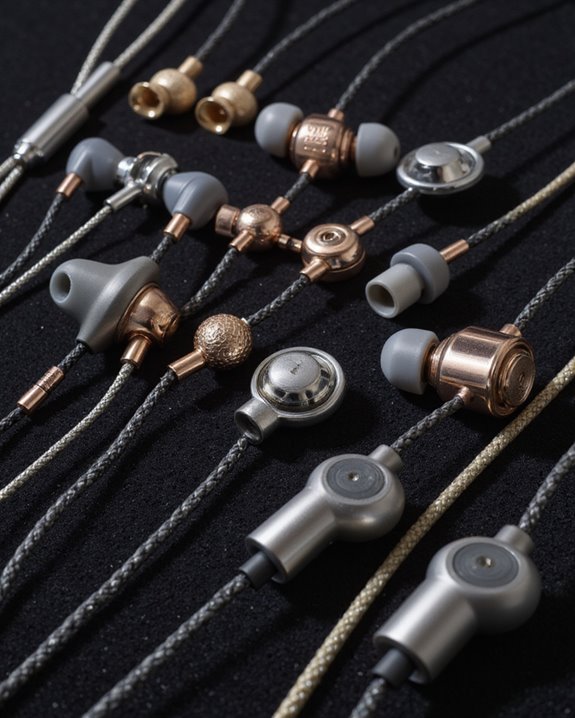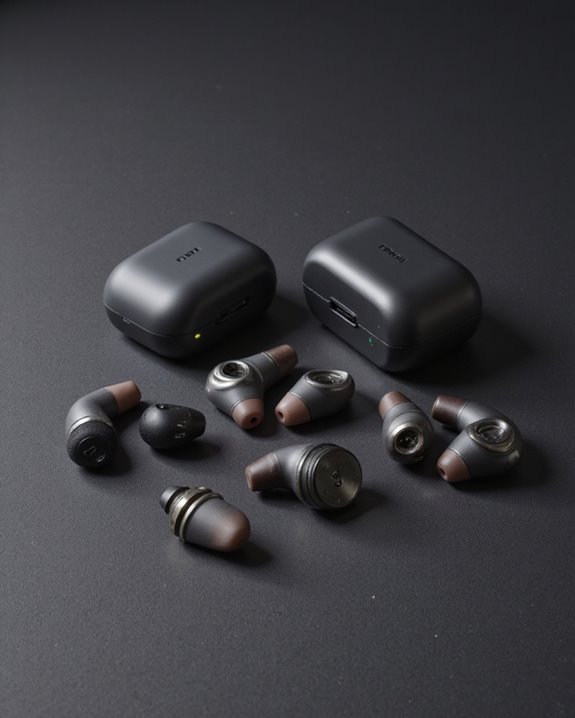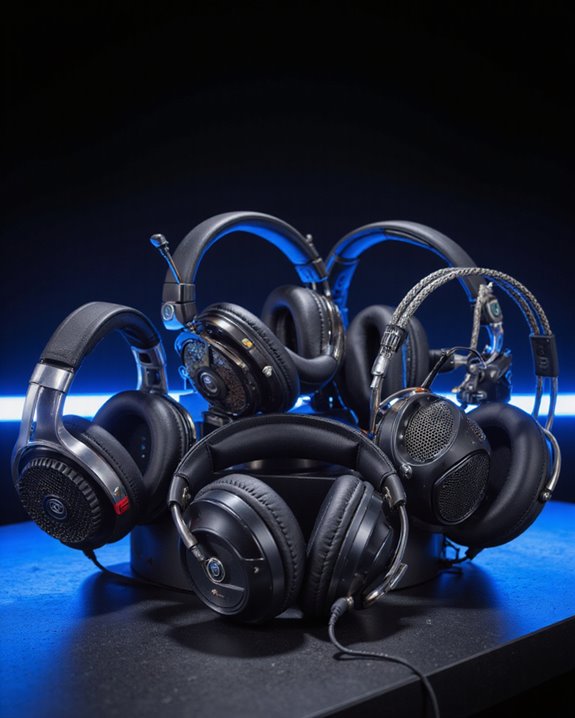Links below are affiliate links. We earn a commission on purchases at no extra cost to you. Although our opinions are based on curated research, we haven't used these products. Articles generated with AI.

3 Best Iem Earbuds
If you’re seeking premium IEM performance, consider these top three options: The Crinacle Zero:BLUE2 delivers exceptional instrument separation with dual dynamic drivers and a V-shaped sound signature. The Linsoul 7Hz x Crinacle Zero:2 offers improved bass response and clear midrange with its 10mm dual cavity driver. The KZ ZS12 PRO X combines 1DD+5BA hybrid configuration for rich bass and crisp highs. Each model features detachable cables and multiple ear tip options to enhance your listening experience.
Key Takeaways
- Crinacle Zero:BLUE2 offers exceptional instrument separation and V-shaped sound signature with warm bass and forward treble through dual dynamic drivers.
- Linsoul 7Hz x Crinacle Zero:2 delivers balanced sound with 3dB bass boost and high-quality build featuring silver-plated oxygen-free copper cable.
- KZ ZS12 PRO X combines 1DD+5BA hybrid configuration for powerful bass and crisp highs with durable zinc alloy construction.
- All three IEMs feature detachable cables with 2-pin connections and come with multiple ear tips for customizable fit.
- Crinacle Zero:BLUE2 includes a bass boost adapter, while the Zero:2 has superior sub-bass extension and KZ ZS12 excels in midrange performance.
Crinacle Zero:BLUE2 Dual Dynamic In-Ear Headphones
TRUTHEAR x Crinacle Zero:BLUE2 Dual Dynamic Drivers in-Ear Headphone with Detachable Cable (3.5mm)
- ZERO:BLUE2 features a dual-cavity internal magnetic circuit dynamic drivers design, incorporating a 10mm solid silica gel suspension composite liquid crystal dome with an...
- Utilizing a DLP-3D printing process for the cavity and a silicone capping technique, these methods are typically reserved for high-end multi-driver products and custom...
- Upgraded Configuration Enhanced Efficiency: Like its predecessors in the ZERO series, the ZERO:BLUE2 features dual dynamic drivers. However, the structure of the 7.8mm...
The Crinacle Zero:BLUE2 stands out as an audiophile-grade IEM that won’t break the bank, featuring dual dynamic drivers that deliver exceptional sound quality at its $70 price point.
You’ll experience a V-shaped sound signature with warm, punchy bass and forward treble, powered by a 10mm silica gel driver and 7.8mm polyurethane driver with N52 and N55 magnets respectively. The IEM’s DLP 3D-printed cavity and silver-plated copper cable guarantee premium audio delivery across its 20Hz-41kHz frequency range.
The detachable 0.78mm 2-pin cable design and lightweight housing provide durability and comfort, while the included bass boost adapter lets you customize your listening experience. With outstanding instrument separation and imaging capabilities, the Zero:BLUE2 outperforms competitors like the Shure SE215 and Moondrop Chu.
Best For: Audiophiles and music enthusiasts seeking high-quality sound performance with customizable bass response at a budget-friendly price point.
Pros:
- Exceptional instrument separation and imaging for the price range
- Detachable cable design with premium materials (silver-plated copper)
- Includes bass boost adapter for sound customization
Cons:
- Bass lacks deep sub-bass extension
- Some users report fit issues
- Average soundstage performance compared to competitors
Linsoul 7Hz x Crinacle Zero:2 In-Ear Monitor Earbuds
Sale
Linsoul 7Hz x Crinacle Zero:2 in Ear Monitor, Updated 10mm Dynamic Driver IEM, Wired Earbuds...
- 【𝟕𝐇𝐳 𝐱 𝐂𝐫𝐢𝐧𝐚𝐜𝐥𝐞: 𝐓𝐡𝐞 𝐂𝐨𝐥𝐥𝐚𝐛𝐨𝐫𝐚𝐭𝐢𝐨𝐧 𝐓𝐡𝐚𝐭 𝐌𝐚𝐝𝐞...
- 【𝐌𝐨𝐫𝐞 𝐁𝐚𝐬𝐬, 𝐊𝐞𝐞𝐩𝐢𝐧𝐠 𝐓𝐨𝐧𝐚𝐥 𝐄𝐱𝐜𝐞𝐥𝐥𝐞𝐧𝐜𝐞】The original Zero had one of the...
- 【𝐍𝐞𝐰 𝟏𝟎𝐦𝐦 𝐃𝐲𝐧𝐚𝐦𝐢𝐜 𝐃𝐫𝐢𝐯𝐞𝐫】The improvements in the tonal characteristics of the Zero:2 were made possible...
Audiophiles seeking precise sound reproduction will find exceptional value in Linsoul’s 7Hz x Crinacle Zero:2 IEMs, a collaborative upgrade to their popular predecessor. This refined model features a new 10mm dual cavity dynamic driver with PU+Metal composite diaphragm, delivering enhanced bass response and clearer midrange reproduction.
You’ll notice a 3dB boost in low frequencies while maintaining excellent tonal balance across the 10Hz-20kHz range. The upgraded high-purity oxygen-free copper cable with silver plating guarantees ideal signal transmission, while the detachable design adds convenience.
With 108dB sensitivity and a comfortable rounded tip design, you’re getting remarkable sound quality that’s earned a 4.3/5 star rating from users. The included S/M/L bore tips help you achieve the perfect fit for extended listening sessions.
Best For: Audiophiles and music enthusiasts seeking high-quality, budget-friendly in-ear monitors with accurate sound reproduction and enhanced bass response.
Pros:
- Excellent sound quality with improved bass and clear midrange thanks to the 10mm dual cavity dynamic driver
- High-quality detachable cable with silver-plated oxygen-free copper construction
- Multiple ear tip sizes included for customizable fit and comfort
Cons:
- Cable length may be too short for some users
- Some users report challenges finding the right ear tip fit
- Limited color options and basic aesthetic design compared to competitors
KZ ZS12 PRO X Hybrid Wired Gaming Earbuds
KZ ZS12 PRO X in Ear Monitor IEM Headphones,1DD+5BA Hybrid Wired Gaming Earbuds,KZ in Ear Monitor...
- 1DD+5BA Hybrid KZ inner wired headphones kz zs12 pro x iem for gaming earbuds each frequency band of low frequency,mid-frequency,high-frequency and ultra-high frequency...
- Profession Acoustic Hardware Configuration earbuds gaming iems KZ ZS12 PRO X in-ear monitors wired headphones for singers adopts a combination of 10mm super-liner inner...
- profession sound quality iem earbuds headphones kz zs12 prox inner iem headphones the dynamic driver is responsible for the low and mid-frequency bands,which can provide...
Professional musicians and discerning audiophiles seeking premium sound at a mid-tier price point will find exceptional value in KZ’s ZS12 PRO X hybrid wired earbuds. These IEMs pack a powerful 1DD+5BA hybrid driver configuration, featuring a 10mm dynamic driver for rich bass alongside five balanced armature drivers for crisp highs.
You’ll appreciate the durable zinc alloy construction and detachable silver-plated 2pin cable that enhances signal conductivity. The frequency response spans an impressive 20Hz-40,000Hz, while the 106dB sensitivity guarantees robust output across the spectrum.
Real-world performance delivers pronounced midrange in the 800Hz-12kHz range, with particularly strong bass response. Multiple users, including professional musicians, have favorably compared these to custom IEMs costing several times more.
Best For: Professional musicians, audiophiles, and serious music enthusiasts seeking high-quality hybrid IEMs with premium sound characteristics at a mid-range price point.
Pros:
- Impressive hybrid driver configuration (1DD+5BA) delivering rich bass and crisp highs
- Durable zinc alloy construction with detachable silver-plated cable
- Excellent value compared to more expensive custom IEMs
Cons:
- Some users report fit issues with the included tips
- Cable length may be too short for some users
- No microphone or inline controls included
Factors to Consider When Choosing IEM Earbuds

When selecting your ideal IEM earbuds, you’ll need to evaluate several essential technical factors that directly impact performance and user experience. Your choice of driver type and configuration, whether it’s dynamic, balanced armature, or hybrid setups, will greatly influence the sound quality and frequency response you’ll experience. The build materials, ergonomic fit, sound signature preferences, and detachable cable options are equally important elements that’ll determine both your long-term satisfaction and the earbuds’ durability.
Driver Type and Configuration
Understanding the driver type and configuration of IEM earbuds is essential since these components directly impact your listening experience. You’ll encounter three main driver types, each with distinct advantages.
Dynamic drivers excel at producing powerful bass frequencies through their moving diaphragms, typically sized around 10mm. Balanced armature drivers, on the other hand, deliver precise mid and high frequencies with exceptional clarity and efficiency.
For the best of both worlds, you’ll find hybrid configurations that combine dynamic and balanced armature drivers. These setups offer enhanced performance across the full frequency spectrum (20Hz-40kHz) while improving instrument separation. Multiple drivers working together can handle different frequency bands more effectively.
When examining specifications, look for sensitivity ratings around 100-110dB, as this indicates how efficiently the drivers convert electrical signals into sound.
Sound Signature Preferences
Your ideal sound signature forms the foundation of an enjoyable listening experience with IEM earbuds. You’ll need to choose between balanced tunings that deliver consistent sound across frequencies or V-shaped signatures that emphasize both bass and treble for added excitement.
If you’re looking for impactful bass, focus on models with enhanced low-frequency response between 20Hz and 100Hz. For vocal clarity and instrumental accuracy, pay attention to the midrange tuning from 200Hz to 5kHz, ensuring it’s neither too recessed nor overly prominent.
Consider how the treble response (5kHz to 20kHz) affects detail retrieval and overall brightness. The earbuds’ frequency extension capabilities, which can reach up to 40kHz, will influence the soundstage width and imaging precision you’ll experience in your music.
Fit and Comfort Level
A proper fit and comfort level stand as essential factors when selecting IEM earbuds for daily use. You’ll want to focus on models that offer rounded earpiece designs, as they naturally conform to your ear canal’s shape and minimize pressure points during extended wear.
The key to achieving ideal comfort lies in customization options. Look for IEMs that come with multiple ear tip sizes and materials. Foam tips can adapt to your unique ear shape, while lightweight construction (under 3 ounces) prevents fatigue during long listening sessions.
Don’t overlook the importance of a proper seal. When your IEMs fit correctly, they’ll not only stay secure but also deliver better sound isolation. Make sure to test different tip sizes to find the combination that provides both stability and comfort for your specific ear anatomy.
Build Quality Materials
The build quality materials of IEM earbuds directly influence their durability, sound performance, and long-term value. You’ll find premium models featuring metal or composite housings that resist wear while maintaining ideal weight distribution for comfort during extended listening sessions.
High-purity conductors, particularly silver-plated cables, guarantee efficient audio transmission with minimal signal degradation. The latest manufacturing techniques, including 3D-printed acoustic chambers, deliver precise internal structures that enhance sound isolation and structural integrity.
When examining build quality, pay attention to the ear tips’ material composition. Whether you choose silicone or foam options, they’ll greatly impact both comfort and noise isolation. Additionally, look for models with detachable cables and high-quality connectors, as these features allow for easy maintenance and guarantee your IEMs remain reliable over time.
Cable Design Options
Understanding cable design options empowers you to select IEMs that’ll deliver best performance and durability. You’ll want to assess detachable cables with 2-pin connectors, which let you easily replace or upgrade your cables as needed.
When examining conductor materials, look for silver-plated options and oxygen-free copper. These materials optimize signal conductivity while resisting oxidation, ensuring your IEMs maintain pristine sound quality over time.
The cable’s internal structure matters too. Coaxial designs separate signal paths to minimize interference, while multi-core configurations with hundreds of strands provide flexibility and reduce unwanted cable noise. You’ll appreciate how these advanced structures prevent tangling during daily use.
Before making your choice, evaluate whether the cable’s construction matches your usage patterns and sound quality requirements.
Price-to-Performance Ratio
Beyond cable considerations, smart shoppers know that maximizing value means evaluating price-to-performance ratio when selecting IEM earbuds.
You’ll want to assess how key specifications like frequency response and sensitivity align with the price point. Compare detailed performance metrics, including driver efficiency and sound fidelity scores, against the cost to identify models that deliver best value.
Calculate the ratio by dividing overall performance scores by price to make objective comparisons across different models. Higher ratios indicate that you’re getting substantial benefits in sound quality, build durability, and comfort without paying disproportionately more.
Focus on models where incremental improvements in critical features don’t come with steep price increases. This systematic evaluation helps you find IEMs that offer the best balance of essential attributes within your budget.
Frequency Response Range
A key technical specification to examine when selecting IEM earbuds is their frequency response range, which determines the full spectrum of sound they can reproduce. When you’re shopping for IEMs, look for models offering coverage from 20 Hz to 20 kHz at minimum, as this matches the typical human hearing range.
You’ll want to pay attention to both ends of the spectrum. IEMs that reach below 20 Hz can deliver deeper, more impactful bass that you’ll feel as well as hear. At the higher end, frequencies extending beyond 20 kHz contribute to crisper treble and enhanced detail in vocals and instruments.
Remember that while wider ranges are impressive on paper, the accuracy of frequency reproduction within that range is equally important for balanced, high-fidelity sound performance.
Isolation and Seal
When selecting IEM earbuds, proper isolation and seal serve as critical factors that’ll determine your overall listening experience. A secure seal creates an effective barrier against external noise while ensuring ideal sound delivery directly to your ear canal.
You’ll want to pay close attention to the eartip selection that comes with your IEMs. The material and size of these tips greatly impact how well they’ll seal in your ears. For the best results, you’ll need tips that maintain their position even when you’re moving around.
Without proper isolation, you’ll notice compromised sound quality, particularly in the bass frequencies. A poor seal can let ambient noise seep in while allowing sound to leak out. Make sure to test different tip sizes to find the combination that provides consistent, comfortable isolation for your specific ear shape.
Frequently Asked Questions
How Often Should I Clean My IEM Earbuds?
You should clean your IEM earbuds every 2-3 weeks with regular use, or more frequently if you notice wax buildup or reduced sound quality. Use a soft brush to remove debris from the mesh screens and nozzles, and sanitize the ear tips with alcohol wipes. Don’t forget to clean the cable connections and inspect the filters. Regular maintenance helps prevent audio degradation and extends your IEMs’ lifespan.
Can I Use IEM Earbuds While Exercising or Swimming?
Want to know if your IEMs are workout-friendly? While you can exercise with IEMs, it’s not recommended for intense workouts or swimming. Most IEMs aren’t water-resistant and lack IP ratings for moisture protection. Sweat can damage the sensitive drivers and electronics inside. If you need workout earbuds, consider sports-specific models with at least IPX4 ratings. For swimming, look for earbuds specifically designed for underwater use with waterproof ratings of IPX7 or higher.
What’s the Average Lifespan of High-Quality IEM Earbuds?
High-quality IEM earbuds typically last 2-3 years with proper care, though you’ll likely notice some sound degradation after 18-24 months of regular use. Your IEMs’ lifespan largely depends on maintenance habits, usage frequency, and storage conditions. You can extend their longevity by cleaning them regularly, storing them in a protective case, and avoiding exposure to extreme temperatures. The replaceable cables on most IEMs also help prolong their overall lifespan.
Are Custom-Molded IEMS Worth the Extra Cost?
Perfectly personalized performance makes custom-molded IEMs worth considering if you’re serious about sound quality and comfort. You’ll get superior noise isolation (up to -26dB), better fit retention, and enhanced bass response compared to universal IEMs. While they’re pricier ($500-2000+) and require ear impressions from an audiologist, the custom fit provides unmatched comfort for extended listening. They’re especially valuable if you’re a performer or audio professional needing reliable monitor solutions.
How Do I Prevent Ear Fatigue When Using IEMS for Extended Periods?
To prevent ear fatigue during long IEM sessions, you’ll want to follow these key practices: Keep volume levels moderate (below 85dB), take 15-minute breaks every 2 hours, and achieve proper fit with correctly-sized ear tips. Consider using foam tips instead of silicone for better comfort. You can also try IEMs with a more neutral frequency response, as excessive bass or treble emphasis often contributes to listening fatigue.







